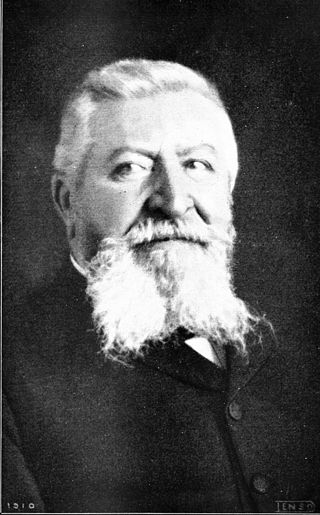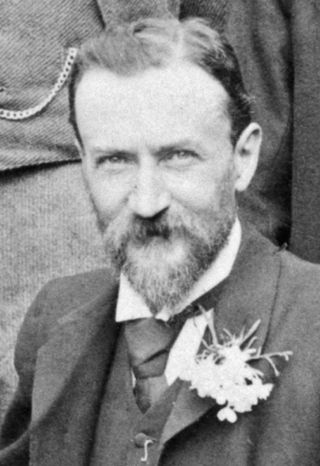
Butterflies are winged insects from the lepidopteran suborder Rhopalocera, characterized by large, often brightly coloured wings that often fold together when at rest, and a conspicuous, fluttering flight. The group comprises the superfamilies Hedyloidea and Papilionoidea. The oldest butterfly fossils have been dated to the Paleocene, about 56 million years ago, though they likely originated in the Late Cretaceous, about 101 million years ago.

Lepidoptera or lepidopterans is an order of winged insects which includes butterflies and moths. About 180,000 species of the Lepidoptera have been described, representing 10% of the total described species of living organisms, making it the second largest insect order with 126 families and 46 superfamilies, and one of the most widespread and widely recognizable insect orders in the world.

Robert Michael Ballantyne was a Scottish author of juvenile fiction, who wrote more than a hundred books. He was also an accomplished artist: he exhibited some of his water-colours at the Royal Scottish Academy.

In evolutionary biology, mimicry is an evolved resemblance between an organism and another object, often an organism of another species. Mimicry may evolve between different species, or between individuals of the same species. In the simplest case, as in Batesian mimicry, a mimic resembles a model, so as to deceive a dupe, all three being of different species. A Batesian mimic, such as a hoverfly, is harmless, while its model, such as a wasp, is harmful, and is avoided by the dupe, such as an insect-eating bird. Birds hunt by sight, so the mimicry in that case is visual, but in other cases mimicry may make use of any of the senses. Most types of mimicry, including Batesian, are deceptive, as the mimics are not harmful, but Müllerian mimicry, where different harmful species resemble each other, is honest, as when species of wasps and of bees all have genuinely aposematic warning coloration. More complex types may be bipolar, involving only two species, such as when the model and the dupe are the same; this occurs for example in aggressive mimicry, where a predator in wolf-in-sheep's-clothing style resembles its prey, allowing it to hunt undetected. Mimicry is not limited to animals; in Pouyannian mimicry, an orchid flower is the mimic, resembling a female bee, its model; the dupe is the male bee of the same species, which tries to copulate with the flower, enabling it to transfer pollen, so the mimicry is again bipolar. In automimicry, another bipolar system, model and mimic are the same, as when blue lycaenid butterflies have 'tails' or eyespots on their wings that mimic their own heads, misdirecting predator dupes to strike harmlessly. Many other types of mimicry exist.

The morpho butterflies comprise many species of Neotropical butterfly under the genus Morpho. This genus includes more than 29 accepted species and 147 accepted subspecies, found mostly in South America, Mexico, and Central America. Morpho wingspans range from 7.5 cm (3.0 in) for M. rhodopteron to 20 cm (7.9 in) for M. hecuba, the imposing sunset morpho. The name morpho, meaning "changed" or "modified", is also an epithet. Blue morphos are severely threatened by the deforestation of tropical forests and habitat fragmentation. Humans provide a direct threat to this genus because their beauty attracts artists and collectors from all over the globe who wish to capture and display them. Aside from humans, birds like the jacamar and flycatcher are the adult butterfly’s natural predators.

Charles Oberthür was a French amateur entomologist specializing in lepidoptera.

Arthur Gardiner Butler F.L.S., F.Z.S. was an English entomologist, arachnologist and ornithologist. He worked at the British Museum on the taxonomy of birds, insects, and spiders.

William Chapman Hewitson was a British naturalist. A wealthy collector, Hewitson was particularly devoted to Coleoptera (beetles) and Lepidoptera and, also, to birds' nests and eggs. His collection of butterflies, collected by him as well as purchased from travellers throughout the world, was one of the largest and most important of his time. He contributed to and published many works on entomology and ornithology and was an accomplished scientific illustrator.

Hypolimnas bolina, the great eggfly, common eggfly, varied eggfly, or in New Zealand the blue moon butterfly, is a species of nymphalid butterfly found from Madagascar to Asia and Australia.

Erebiola butleri, or Butler's ringlet, is an elusive New Zealand endemic butterfly, discovered in 1879 by John Enys at the alpine pass at the head of the Rakaia River. It is the only member of the genus Erebiola.

The subfamily Theclinae is a group of butterflies, often referred to as hairstreaks, with some species instead known as elfins or by other names. The group is part of the family Lycaenidae, the "gossamer-winged butterflies". There are many tropical species as well as a number found in the Americas. Tropical hairstreaks often have iridescent blue coloration above, caused by reflected light from the structure of the wing scales rather than by pigment. Hairstreaks from North America are commonly brown above. Few Theclinae are migratory. Members of this group are described as 'thecline'.

Prosotas dubiosa, the tailless lineblue or small purple lineblue, is a blue butterfly (Lycaenidae) found in Asia to Australia. The species was first described by Georg Semper in 1879.

Ithomiini is a butterfly tribe in the nymphalid subfamily Danainae. It is sometimes referred to as the tribe of clearwing butterflies or glasswing butterflies. Some authors consider the group to be a subfamily (Ithomiinae). These butterflies are exclusively Neotropical, found in humid forests from sea level to 3000 m, from Mexico to Argentina. There are around 370 species in some 40–45 genera.

Mahoba is a genus of moths in the subfamily Lymantriinae. The genus was erected by Frederic Moore in 1879.

Cethosia, commonly called the lacewings, is a genus of butterflies of the subfamily Heliconiinae in the family Nymphalidae. They are found mainly in southeastern Asia as far south as Australia.

Myrina silenus, the common fig-tree blue, is a butterfly of the family Lycaenidae. It is found in Sub-Saharan Africa, southern Arabia and northern Oman.

Rapala manea, slate flash, is a butterfly of the family Lycaenidae. It is found in most of the Indomalayan realm.

Catapaecilma evansi is a species of butterfly belonging to the lycaenid family described by Henry Maurice Pendlebury in 1933. It is found in Southeast Asia.
Heosphora is a genus of moths in the family Pyralidae. The genus was first described by Edward Meyrick in 1882. The type species is Anerastia psamathella Meyrick, 1879, designated as such by George Hampson in 1901. All Heosphora species are found in Australia.


















